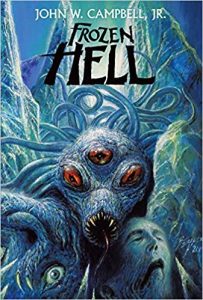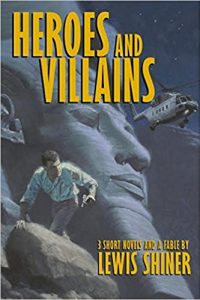Richard A. Lupoff Reviews Frozen Hell by John W. Campbell, Jr.
 Frozen Hell, John W. Campbell, Jr. (978-14794-4283-6, $29.99, 159pp) June 2019. Cover by Bob Eggleton.
Frozen Hell, John W. Campbell, Jr. (978-14794-4283-6, $29.99, 159pp) June 2019. Cover by Bob Eggleton.
When F. Orlin Tremaine, editor of Astounding Stories, was promoted to supervision of Street & Smith’s magazine division in 1937, his hand-picked successor was one of his star authors, a young man named John W. Campbell, Jr. Despite being a popular author, Campbell was struggling with the unreliable income of a freelance writer; he was quick to accept the editorship of Astounding (which he promptly rechristened Astounding Science Fiction). He stopped writing stories and thereafter devoted his efforts to building one of the most successful – and controversial – editorial careers in the history of science fiction. He held the post at Astounding, later rechristened Analog Science Fiction and Fact, until his death in 1971.
He also faced the puzzle of what to do with a manuscript which he had submitted to Tremaine, and now inherited back with the editorship of Astounding. It was not unusual for pulp editors to buy their own stories, but a common practice was to publish those self-serving pieces under a pseudonym, and Campbell published his own inherited story under the by-line of “Don A. Stuart.”
The story, titled “Who Goes There?”, was an immediate hit with readers. In the 82 years since its first publication, “Who Goes There?” has been anthologized countless times. It is a cornerstone of any anthology of classic science fiction. It has been filmed three times, first as The Thing from Another World, then twice simply as The Thing. Each version is severely flawed, but each has its supporters. I will advocate for the first of the three; I vividly remember the day I saw it with two friends, and the impact that it had on me.
We now come to a recent day, when Alec Nevala-Lee, a burgeoning SF writer and scholar, is studying the papers of John W. Campbell, Jr., in the Houghton Library at Harvard. Nevala-Lee got to read preliminary drafts of several Campbell stories, plus some that had never been published – and a complete short novel titled Frozen Hell. Apparently Campbell had tried this title on a book that was eventually published as The Moon is Hell. But this manuscript was not the source of that book. In fact, it was a preliminary, never-published, draft of Campbell’s last and greatest work of fiction, “Who Goes There?”
Now enters Robert Silverberg, arguably the greatest science fiction writer of his generation. Silverberg, no mean scholar himself, was able to trace Frozen Hell to its origin in the mid-1930s. Campbell had written the story at short-novel length. Hoping to sell it to a better-paying market than the three science fiction magazines then extant (Amazing Stories, Thrilling Wonder Stories, and Astounding Stories), Campbell tried to place Frozen Hell with Argosy, a leading “variety pulp” that ran western stories, mysteries, swashbucklers – and science fiction. Campbell would be competing with the likes of Edgar Rice Burroughs and A. Merritt.
The editor of Argosy, Jack Byrne, apparently tried to let Campbell down easy. According to Silverberg, Byrne praised the story as “a good yarn, good idea, good writing.” But he condemned its lack of characterization, and turned it down.
In the meanwhile, Campbell had been selling short stories to Thrilling Wonder Stories, a bottom-feeder market edited by longtime science fiction enthusiast Mort Weisinger. Weisinger had been looking for a successor to the recently deceased Stanley G. Weinbaum. Weinbaum had specialized in lightweight, clever stories, often featuring appealing aliens. Campbell took Weisinger up with a series of short stories about a pair of interplanetary adventurers named Penton and Blake. He tried Weisinger with a story called “Imitation”, which Weisinger renamed “Brain-Stealers of Mars”. It was a gimmick story about an alien species capable of imitating other species – including humans – down to the last cell, molecule, or atom.
Puzzle: How do you tell an alien in the guise of a human, from a real human? Campbell worked out an answer that was both ingenious and plausible. “Brain-Stealers” led to a series of light entertainments featuring Penton and Blake. The stories eventually became half of an Ace Double. They’re still fun to read.
Campbell apparently lost hope for Frozen Hell, but rather than give up on the project, he rewrote it. The main difference was truncating the opening sequence that was largely devoted to establishing the setting, a research station on the Antarctic ice cap. The story really gets going – as anyone who has read “Who Goes There?” or seen any of the three films knows – when an alien spaceship and an ancient astronaut are discovered frozen in a glacier.
By melding the “Brain-Stealers” gimmick with the Antarctic setting, abandoning the light touch, and writing the story as one fraught with menace and suspense, Campbell created as gripping a narrative as the science fiction field has ever produced. The Wildside Press edition is a tribute to Campbell. There is a splendid wraparound jacket painting by Bob Eggleton, along with end papers and chapter illustrations. Nevala-Lee’s and Silverberg’s contributions do a marvelous job of setting the literary and historical background for the book
A surprise comes at the end: a preview of a planned sequel, Imagine a modern expedition to the South Pole. In the 1937 version, the characters are all white males. High tech was an autogiro. By the 1951 film, two female characters were added to the cast and the ‘gyro was replaced by a ski-equipped DC-3. In the new sequel – the publisher gives only a few chapters, enough to whet the taste – the scientists and military personnel are multi-ethnic and of mixed gender. It takes a little getting used to, to become comfortable with the up-to-date narrative.
And “Who Goes There?” is such a masterpiece – imagine someone writing Abraham Lincoln’s “Gettysburg Change-of-Address” or Moussorgsky’s “Night on Crew-Cut Mountain”.
One other problem: the Wildside edition really needs some serious proofreading. Eggleton’s name is misspelled on the title page, and the table of contents has weirdly erroneous pagination. But don’t let these flaws spoil your reading pleasure. I absolutely loved immersing myself in this book. I’d no sooner finished reading it than I called up the 1951 film on my computer screen and sat here shivering.
Go thou and do the same!
This review and more like it in the September 2019 issue of Locus.
 While you are here, please take a moment to support Locus with a one-time or recurring donation. We rely on reader donations to keep the magazine and site going, and would like to keep the site paywall free, but WE NEED YOUR FINANCIAL SUPPORT to continue quality coverage of the science fiction and fantasy field.
While you are here, please take a moment to support Locus with a one-time or recurring donation. We rely on reader donations to keep the magazine and site going, and would like to keep the site paywall free, but WE NEED YOUR FINANCIAL SUPPORT to continue quality coverage of the science fiction and fantasy field.





